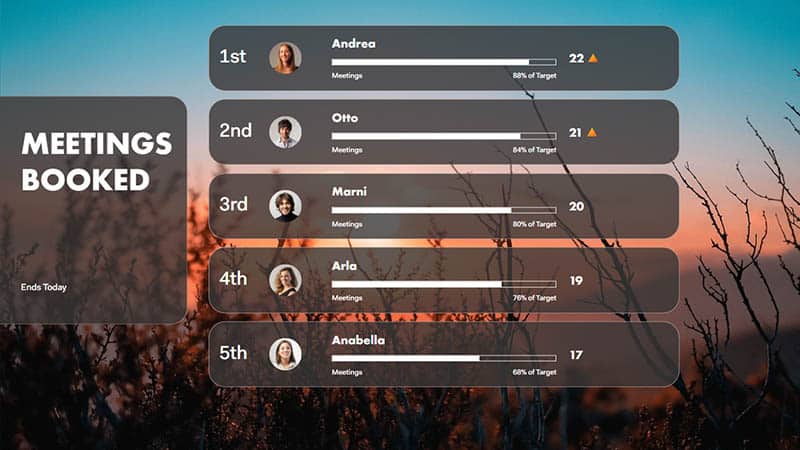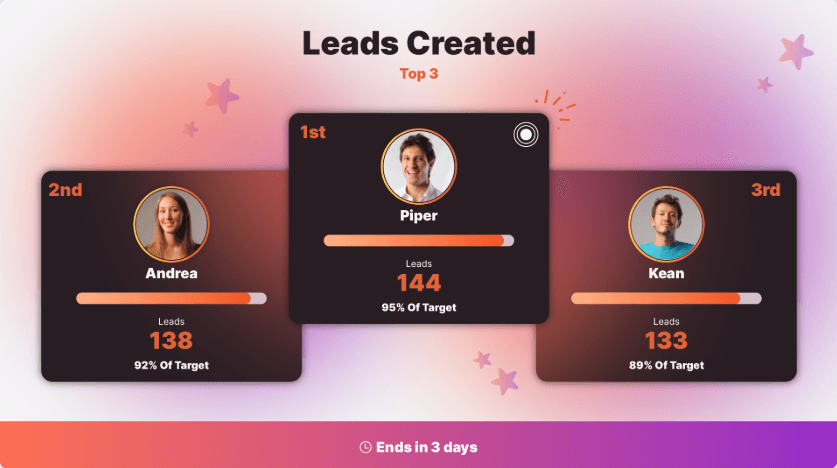Check out these examples of HubSpot gamification. Getting HubSpot CRM is crucial for customer relationship management in modern-day organizations as it helps them organize a lot of their dashboard in one simple place. That helps improve overall reporting and employee management. However, some people believe employing HubSpot CRM won’t automatically instill a sense of competition among employees.
CRM serves several different roles and can generally improve the overall efficiency of the organization. However, it doesn’t play a role in employee motivation. To effectively increase employee motivation and foster a sense of competition within the organization, it’s Gamification that you’re going to need.

HubSpot offers sales gamification software integration that can allow you to take your organization to the next level. Gamification is no longer just a standard buzzword, and many organizations are starting to implement it with positive results. Here’s everything that you need to know about Gamification and how you can integrate it with HubSpot to manage everything efficiently.
What Is HubSpot Gamification?
refers to applying game-design elements and specific mechanics to non-game situations. Gamified CRM refers to the integration of game-design elements into CRM systems to enhance employee engagement and customer interaction. The use of game mechanics has been much more prevalent in education, with clear evidence of success. That same concept is now making its way towards organizations.
By translating several in-game mechanics to the operations of different organizational teams, business owners can significantly improve competition and motivation.
How Do Game Elements Work in Gamification?
As mentioned before, Gamification involves the use of several in-game elements and integrating them with business operations. Gamification can also leverage customer data to drive brand loyalty, customer retention, and increased sales. Here are some of the most ideal game-design elements that translate well to an organization.
Points

One of the most common features that video games use to keep players engaged is a points system. Points are generally an indication of how well you’re doing in a particular game. The game will reward you for doing certain things that the game mechanics declare a good action.
Gamers tend to do everything they can to earn as many points as possible so they can showcase their progress. That easily translates to an organizational setting. For example, for a content marketing team, each piece of content that the members generate will earn them a certain number of points.
That’ll encourage workers to generate as much content as possible and accumulate as many points as they can!
You can set up a different number of points for different tasks. The harder, more challenging tasks will present more points, while standard tasks will earn a fewer number of points. That way, you can ensure that your employees are engaged no matter how menial the task might seem.
It’s also a good way for employees to measure their progress and receive immediate feedback. Being successfully rewarded points for completing a task is a great example of immediate feedback.
Leaderboards

In connection to the points system that games employ, a leaderboard works exceptionally well in keeping the players engaged and motivated. A leaderboard showcases the best performing players in the game at a certain point in time. It keeps players motivated to keep trying and achieve a good ranking on the leaderboard.
Similarly, an active leaderboard can help organizations engage a healthy competitive environment within the organization. It can also help the organization see which employees are performing the best.
Aside from that, it can showcase employees where they stand and how much work they need to do to reach the level of other employees. You can also set up a reward system and award the employee at the top of the leaderboard with extra points. That can incentivize other employees to try and reach the top. It’ll contribute towards helping improve the overall sense of competition between the employees.
Badges

Aside from points and leaderboards, the other game-design elements that work effectively to motivate the employees and build a sense of competition are badges. These badges can serve a major role in ensuring that players keep coming back to video games. As they spend a certain amount of time in a video game, without anything to work towards, it can get boring.
That’s where badges come into the picture to help improve the overall engagement with the game. Similarly, organizations can choose to assign different badges for different achievements. For example, a sales team can set up badges for 50 sales, 100 sales, 500 sales, and so on!
Employees can also have the option to display badges and showcase their achievements. It can also give employers the opportunity to assess and see which employees excel at performing which types of tasks.
There are more game mechanics that work well within organizations, but these are the three main ones that businesses employ!
Benefits of Gamification

Now that you have a better understanding of Gamification, here are some of the benefits that organizations can expect to receive after implementing it properly in their organization.
High Levels Of Employee Engagement to Motivate Employees
Employee engagement plays a major role in how well an organization performs and showcases how well your employees dedicate themselves to their work. For an organization to grow properly, it needs to cultivate a culture that promotes employee engagement.
An easy way to promote the overall engagement levels in the organization is by employing a gamification system. Through a gamified system, even the most menial organizational tasks start to become more engaging for employees.

After employing Gamification, you’ll notice a significant difference in overall employee engagement, especially if the gamification dashboard incorporates an effective way of tracking employee progress like a points system. Additionally, a gamification dashboard can also provide real-time updates and actionable insights aimed at enhancing sales performance.
Easier Employee Onboarding
Employing a gamification system means that it’s much easier for organizations to bring new employees up to speed. The gamification dashboard provides them with easy access to all the tasks that they’re meant to perform and the importance of each particular task.
Through the gamification system, new employees will also receive immediate feedback, which improves their overall engagement levels with the organization. Receiving timely feedback will only help accelerate their progress.
It also gives a chance to the employers to see how the new employees are progressing and whether they need some additional assistance getting up to speed with the organization.
Healthy Competition
For a business to thrive, there needs to be a healthy sense of competition among employees. Nothing too cutthroat cause that can contribute to a very toxic work environment, but some level of competition can greatly benefit an organization.
What most organizations struggle with is finding the right balance and creating a competitive environment that’s actually healthy. Gamification can allow you to foster a competitive environment without pitting your employees against one another.
Employees can even interact with one another through Gamification by comparing their profiles and seeking tips on how to improve at performing a certain task.
Alignment With Business Goals
Another benefit of using Gamification is that it becomes much easier to get your employees on board with the organizational goals. Instead of having to manually discuss organizational goals with employees, you can just integrate the organizational goals into the gamification dashboard so your employees can always work towards them!
Through Gamification, employees can also get a better idea of their overall contribution to the business goal. By being more in touch with their own contribution, employees will be encouraged to work better and improve their overall productivity levels.
CRM Gamification Integration With Hubspot
One of the most significant benefits of Hubspot is that it offers support for Gamification through the gamifier platform. Hubspot users can easily introduce Gamification to their employees through the platform. The integration will provide each employee with a gamifier home page that they can use to check their performance and see how well they’re doing. There are different leaderboards, questions options, and even challenges that the employers can set for the employees.
The gamifier platform also provides a convenient rewards page that employers can customize. Employees can use the points that they earn through their work and spend it here to receive gifts. You can set up the gifts after consulting with your employees, so there’s actually a level of motivation to work towards.
Users can also access the gamifier page through the mobile app and access everything that they need. There’s also a timeline that sends notifications to all team members when someone performs a certain action.
Through gamifier, organizations can easily integrate Gamification into their Hubspot CRM. It’s a convenient way to ensure that they have everything they need in one effective dashboard.
Implementing HubSpot Gamification
Implementing HubSpot gamification requires a strategic approach to maximize its effectiveness. Here are some steps to follow:
Setting Up Performance Targets
- Define Clear Objectives: Start by identifying the specific behaviors or outcomes you want to encourage in your sales team. Whether it’s increasing sales revenue, improving customer acquisition, or enhancing customer satisfaction, having clear objectives will guide your gamification strategy.
- Choose Relevant Metrics: Select key performance indicators (KPIs) that align with your objectives. These could include metrics like sales revenue, number of new customers acquired, or customer satisfaction scores. Choosing the right KPIs ensures that your gamification efforts are focused and measurable.
- Set Achievable Targets: Establish realistic targets for your sales team, considering their current performance and potential for growth. Setting achievable targets helps maintain motivation and ensures that the goals are within reach, fostering a sense of accomplishment.
- Create a Reward System: Design a reward system that appeals to your sales team. This could include points, badges, or leaderboards. A well-thought-out reward system can significantly boost motivation and engagement, encouraging your team to strive for excellence.
Creating a Custom Narrative
- Develop a Compelling Story: Create a narrative that resonates with your sales team, highlighting the importance of their role in achieving business goals. A compelling story can make the gamification experience more engaging and meaningful.
- Use Gamification Elements: Incorporate game elements such as challenges, quests, or missions to make the narrative more interactive. These elements can add excitement and variety to the sales process, keeping your team engaged.
- Personalize the Experience: Tailor the narrative to individual sales reps, considering their strengths, weaknesses, and motivations. Personalization can make the gamification experience more relevant and impactful for each team member.
- Continuously Update and Refine: Regularly update and refine the narrative to keep it fresh and exciting. Reflect changes in business goals or market conditions to ensure the narrative remains relevant and motivating.
Best Practices for HubSpot Gamification
- Align with Business Goals: Ensure that your gamification strategy aligns with your business objectives, such as increasing sales revenue or improving customer satisfaction. This alignment ensures that gamification efforts contribute directly to your organization’s success.
- Keep It Simple and Intuitive: Design a gamification system that is easy to understand and use. Avoid complexity and confusion to ensure that all sales reps can engage with the system effectively.
- Provide Immediate Feedback: Offer immediate feedback and recognition to sales reps using game elements such as points, badges, or leaderboards. Immediate feedback helps reinforce positive behaviors and keeps motivation high.
- Foster Healthy Competition: Encourage healthy competition among sales reps by using game elements such as challenges or quests. Healthy competition can drive engagement and motivation without creating a toxic work environment.
- Continuously Monitor and Evaluate: Regularly monitor and evaluate the effectiveness of your gamification strategy. Make adjustments as needed to optimize results and ensure that the system continues to motivate and engage your sales team.
Final Thoughts on Gamification CRM
Most organizations make the mistake of getting a CRM platform and think that’s all they’re going to need to motive employees. However, that’s far away from the truth. A CRM software on its own isn’t going to engage and motivate your employees.
You can motivate employees by integrating Gamification into your CRM software. Thanks to HubSpot’s gamifier integration, that’s easier than ever before.
Gamification is a new organizational strategy that involves applying different game elements to the operations of the organization. Its main goal is to increase employee motivation and engagement. As Gamification becomes more and more prevalent among organizations, the benefits that it provides are becoming much more evident. Organizations that aren’t employing Gamification in the same way in their organization are lagging behind.



